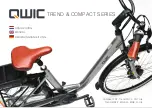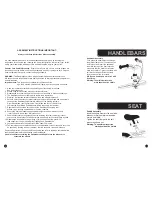
14.
1. With the rider off of the bike, attach a high pressure precision air
pump with gauge to the threads and add air pressure equal to the rider’s
weight (in p.s.i.). If you turned the shock to more easily access the
Schrader valve, rotate the shock back to a position where you can easily
reach the blue shock compression adjuster and retighten the shock lock
ring. Then compress the suspension once to charge the negative air
spring. This inflation is a good starting point, but can be fine tuned
by following the remaining steps.
2. With the rider off of the bike, slide the shock wiper O-ring (found on
the piston of the rear shock) up to the shock body. If you don’t have a
wiper O-ring on your shock piston, put a zip tie around the piston and
slide it up against the shock body.
3. Have the rider sit on the bike in a normal, relaxed cycling position,
with both feet on the pedals and weight on the seat. It may be easiest
for the rider to lean against a wall or post. It is important that the rider
not bounce the bike. Then have the rider carefully dismount the bike,
again being careful not to bounce the bike.
4. Measure the distance between the O-ring or zip tie and the shock
body. This initial compression is the suspension “sag.”
5. Most riders prefer to set the preload so that the bike’s rear shock
compresses about 1/4” when the rider is seated in a normal, relaxed
riding position. Add or release air pressure to the suspension, compress
the shock once, and recheck your measurements to achieve the desired
sag setting.
NOTE: Rear suspension preload is a matter of personal preference. We en-
courage riders to experiment with different preload settings and find the set-
ting that suits them best. If too much preload is set, the suspension will be
stiff and unresponsive over small bumps. Alternately, if the preload is too
soft, the rider may feel some amount of “bouncing” while climbing or sprint-
ing, and may tend to bottom out the shock (compress it to the limit of its
travel) on large bumps.


































